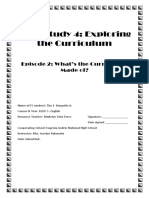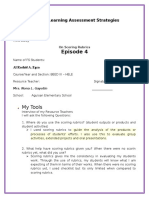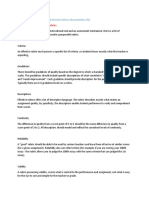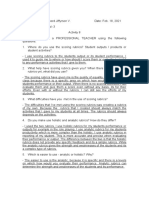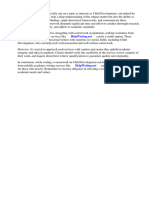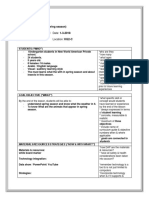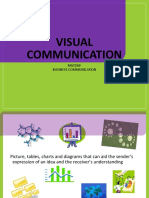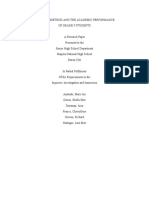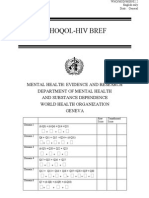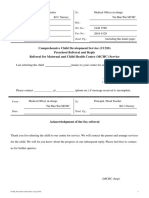FS 5 Epsd 4
FS 5 Epsd 4
Uploaded by
Egca DihsarlaCopyright:
Available Formats
FS 5 Epsd 4
FS 5 Epsd 4
Uploaded by
Egca DihsarlaOriginal Description:
Original Title
Copyright
Available Formats
Share this document
Did you find this document useful?
Is this content inappropriate?
Copyright:
Available Formats
FS 5 Epsd 4
FS 5 Epsd 4
Uploaded by
Egca DihsarlaCopyright:
Available Formats
Learning Assessment Strategies
Field Study On Scoring Rubrics
Episode 4
Name of FS Students:
Al Rashid A. Egca
Course/Year and Section: BEED III HELE Resource Teacher: Mrs. Nona L. Gayotin School: Aguisan Elementary School Signature ______________
My Tools
Interview of my Resource Teachers I will ask the following Questions: 1. Where do you use the scoring rubrics? (student outputs or products and student activities) I used scoring rubrics to guide the analysis of the products or processes of students' efforts. I also use this to evaluate group activities, extended projects and oral presentations.
2. What help have scoring rubrics given you? When there were no scorin rubrics yet, what did you use? Scoring rubrics gives me the consistency in evaluating my students work. Through the use of rubrics, my students will know what I am expecting of them in terms of their works. When there were no scoring rubrics yet, I used checklist but its only limited when compared to scoring rubrics.
3. What difficulties have you met in the use of scoring rubrics? My difficulties in using rubrics is that good rubrics are difficult to construct. Sometimes students met the criteria of rubrics but still their works are not that good. In making rubrics it should be written in a meaningful way.
4. Do you make use of holistic and analytic rubrics? How do they differ? Yes, I used both of the rubrics because it helps me a lot. They differ from each other in the sense that Analytic rubrics identify and assess components of a finished product while Holistic rubrics assess student work as a whole.
5. Which is easier to use analytic or holistic? Both rubrics are easy to used. Neither rubric is better than the other. Both have a place in authentic assessment, depending on who is being taught and how many teachers scoring the product.
6. Were you involved in the making of scoring rubrics? How do you make one? Which is easier to construct- analytical or holistic? In making scoring rubrics, most of the teahers are not involved because scoring rubrics are always uniform in many school because it is from the higher office. In my own opinion, holistic rubrics is easy to construct because it assessed the totality of a specific product or project in a quicker time.
Research
I will research on the following: Types of Rubrics Holistic rubrics consists of a single scaleall factors that are to be evaluated are identified together for each level of performance. It might be a checklist or a description of each attainable level of performance. Analytical rubrics are excellent tools for teaching as well as for assessment. An analytical rubric consists of multiple, separate scales, and therefore provides a set of scores rather than just one. The multiple scales enable students to pinpoint their strengths and weaknesses related to each criterion. The analytical
rubric provides feedback to students by letting them know exactly which elements of the skill were mastered and which need more practice. When to use rubrics Rubrics are best suited for situations where a wide range of variation exists between whats considered very proficient and whats considered not yet proficient. Teachers have found rubrics to be every useful in providing guidance and feedback to students where skills and processes are the targets being monitored. Examples of skills or processes that adapt well to being rubriced include: the writing process, the application of the method of scientific inquiry, thinking skills (i.e. constructing support, compare, problem solving, etc.), and life-long learner skills (i.e. collaborative worker, quality producer, etc.).
How to construct the two types of rubrics Analytic rubrics can be created in Excel (and information can easily be aggregated and numerically summarized), with Word's table function, or even just sketched out on a pad of paper. Additionally there are several free (though generally registration is required) on-line generators for rubric creation. How an analytical rubric is created: 1. Determine the various skills and abilities that students should demonstrate to show achievement of the learning outcome(s). 2. determine the levels of achievement possible given the expectations of what students are to be able to demonstrate. 3. create descriptions for the criteria along each level of achievement. The steps for creating a holistic rubric are similar to that of the analytical, but do not describe each criteria and level of achievement separately as the scorer will be selecting one holistic score for the entire assignment rather than separate scores for each criterion. In general holistic rubrics are considered faster to create and implement, however, they do not facilitate analysis and feedback in the same way as analytical rubrics. 1. Determine all the skills and abilities students need to demonstrate in order to achieve the learning outcome. Clarity, organization, and grammar. 2. Determine the appropriate levels of accomplishment. Needs improvement, developing, sufficient, and above average. 3. Write an overall description of how a student would demonstrate the learning outcome for each level of accomplishment. When creating a holistic rubric this step cannot be skipped.
Advantages and disadvantages of scoring rubrics Advantages of Rubrics in General Forces the teacher to clarify criteria in detail. Useful feedback for the effectiveness of instruction. Motivates students to reach the standards specified. Narrows the gap between instruction and assessment. Flexible tool, having uses across many contexts, in many grade levels and for a wide range of abilities. Potential to be transferred into grades if necessary. Can offer a method of consistency in scoring by clearly defining the performance criteria. Giving the child more control of their own learning process. Potential to open communication with caregivers.
Disadvantages of Rubrics in General Rubrics can also restrict the students mind power in that they will feel that they need to complete the assignment strictly to the rubric instead of taking the initiative to explore their learning. If the criteria that is in the rubric is too complex, students may feel overwhelmed with the assignment, and little success may be imminent. For the teacher creating the rubric, they may find the task of developing, testing, evaluating, and updating time consuming.
References:
http://www.indiana.edu/~icy/rubric/rubric_type.html http://www.aea267.k12.ia.us/assessment/rubrics-in-the-classroom/when-to-use-a-rubric http://teachingcommons.depaul.edu/Feedback_Grading/rubrics/creating-rubrics.html http://epsyrubrics.wikifoundry.com/page/Advantages+and+Disadvantages+of+the+Rubric
My Analysis 1. What benefits have scoring rubrics brought to the teaching- learning process?
Scoring rubrics brought many benefits in the teaching learning process. This includes the following: Clarify constraints with students, colleagues, other evaluators, administrators, and yourself. Communicate expectations with students: A rubric tells students what is expected of them, the grading criteria, what counts and what doesn't, how many points they will earn for each task, and how their work is graded. Bring objectivity to subjective scoring. Easy scoring and recording of it. Communicate grades with students: A graded rubric helps students understand how they were graded and what their areas of strength and weakness are.
2. How are scoring rubrics related to portfolio assessment? Portfolios are a kind of authentic assessment and because authentic assessments cannot be graded like traditional assessments, scoring rubrics is just one way to assess portfolios in order to increase the reliability of scores based on human judgment. 3. To get from scoring rubrics, what should be observed in the making and use of scoring rubrics? In making and using score rubrics. First you must have objectives included in the rubrics for a specific activity. A rubric must be definitive, quantitative and objective in nature. The scoring rubric is a device that guides you to keep track the corresponding score or credits that you may give to a particular task.
My Reflections
Reflect on this: Scoring Rubrics: Boon or Bane? Rubrics are used to assess how well a student is doing, academically, in certain areas. They are administered by teachers. As for me scoring rubrics is boon because it is very helpful to teachers and students. As for teachers, it helps them to give grades fairly to students in terms of their works and performances. And as for students, they keep track of their performances.
DOCUMENTATION
Maam Nona with the Grade IV pupils
Sir Al with the Grade IV pupils
You might also like
- Relentless Tim S. GroverDocument2 pagesRelentless Tim S. Groverwanttbe_ingNo ratings yet
- Cross Cultural PsychologyDocument112 pagesCross Cultural Psychologymekit bekeleNo ratings yet
- Answer Fs 5Document17 pagesAnswer Fs 5Mae T Oliva68% (74)
- Field Study 4Document12 pagesField Study 4Son YongNo ratings yet
- FS 3 Episode 7 CHMSCDocument3 pagesFS 3 Episode 7 CHMSCGesrel Formentera91% (34)
- FS5 Ep 1and 2 FinalDocument34 pagesFS5 Ep 1and 2 FinalAdrian Cuebillas73% (56)
- fs4 (Episode 2)Document9 pagesfs4 (Episode 2)Ces Reyes100% (3)
- The Challenger Sale: Commercial Teaching and Your Sales PresentationDocument26 pagesThe Challenger Sale: Commercial Teaching and Your Sales Presentationsampige123No ratings yet
- FS 5 - Activity 6 On Scoring RibricsDocument10 pagesFS 5 - Activity 6 On Scoring RibricsGlydel RodriguezNo ratings yet
- FS 3 Episode 6Document7 pagesFS 3 Episode 6Mark Anthony Nieva RafalloNo ratings yet
- Field Study 5 Learning Episode 1. ASSESSDocument35 pagesField Study 5 Learning Episode 1. ASSESSAlyn Apolo LlenaNo ratings yet
- Episode 6 On Portfolios: My Learning Episode OverviewDocument4 pagesEpisode 6 On Portfolios: My Learning Episode OverviewBlessildajoy Cruz100% (1)
- FIELD STUDY 3 (Episode 1)Document4 pagesFIELD STUDY 3 (Episode 1)Anonymous PzSoNQaORE100% (1)
- Episode 2 fs6Document14 pagesEpisode 2 fs6Mark Anthony Nieva Rafallo100% (1)
- fs4 (Episode 1)Document9 pagesfs4 (Episode 1)Ces ReyesNo ratings yet
- Some Answers For FS4 Episode 9 To 12Document13 pagesSome Answers For FS4 Episode 9 To 12Raez Rodillado93% (15)
- Episode 3 On Content Validity of TestsDocument13 pagesEpisode 3 On Content Validity of TestsLeonilo C. Dumaguing Jr.No ratings yet
- Episode 8 The K To 12 Grading System: My Learning Episode OverviewDocument4 pagesEpisode 8 The K To 12 Grading System: My Learning Episode OverviewBlessildajoy Cruz75% (4)
- Episode 2 Guiding Principle in The Assessment of LearningDocument4 pagesEpisode 2 Guiding Principle in The Assessment of LearningBlessildajoy CruzNo ratings yet
- FS 5 Ep 5-9Document53 pagesFS 5 Ep 5-9nissi guingab64% (53)
- Episode 2Document10 pagesEpisode 2Alezah MagoNo ratings yet
- fs3 Episode 3 DoneDocument4 pagesfs3 Episode 3 Doneapi-30769713485% (13)
- FIELD STUDY 5 Episode 1: Indicators of Assessment FOR, OF, and AS LearningDocument5 pagesFIELD STUDY 5 Episode 1: Indicators of Assessment FOR, OF, and AS LearningbunchNo ratings yet
- Story or Narrative of Non-Filipino Teacher in Other CountriesDocument3 pagesStory or Narrative of Non-Filipino Teacher in Other CountriesDM Camilot II100% (1)
- FS 5 Ep 1-4Document43 pagesFS 5 Ep 1-4nissi guingab66% (87)
- Stakeholders in Curriculum Development: My FS Learning Episode OverviewDocument10 pagesStakeholders in Curriculum Development: My FS Learning Episode OverviewMark Anthony Nieva RafalloNo ratings yet
- Field Study 5 Episode 9Document9 pagesField Study 5 Episode 9Chlesea Marei Alejo Areola43% (7)
- Fs MayenDocument30 pagesFs MayenKatniss CatnipNo ratings yet
- Episode 3 Using Different Assessment Methods, Tools and TaskDocument6 pagesEpisode 3 Using Different Assessment Methods, Tools and TaskBlessildajoy CruzNo ratings yet
- Fs 6 Episode 4 TemplateDocument14 pagesFs 6 Episode 4 Templatemelicyn higoy29% (7)
- Observation Sheet No 2.1: PampangacollegesDocument5 pagesObservation Sheet No 2.1: PampangacollegesNicole Manansala UsiNo ratings yet
- FS3 Episode 3 and 4Document9 pagesFS3 Episode 3 and 4sheila may erenoNo ratings yet
- Episode 6: Tell Me Your Features: - Exploring The CurriculumDocument5 pagesEpisode 6: Tell Me Your Features: - Exploring The CurriculumNeil Patrick FloresNo ratings yet
- FS 4 Learning ActivitiesDocument23 pagesFS 4 Learning Activitiessiena jimenez84% (19)
- Principles of LearningDocument3 pagesPrinciples of LearningJean MaltiNo ratings yet
- Field Study 6: Episode 2Document25 pagesField Study 6: Episode 2Krystel Bombita50% (2)
- Learning Episode 3Document14 pagesLearning Episode 3Jemmuel SarmientoNo ratings yet
- FS3 Ep 8Document8 pagesFS3 Ep 8Kel LiNo ratings yet
- Field Study 3Document40 pagesField Study 3api-307684211No ratings yet
- FS 4 Episode 7Document5 pagesFS 4 Episode 7Raymund UyNo ratings yet
- Episode 7Document5 pagesEpisode 7Graciele Joie ReganitNo ratings yet
- Fs 5 Episode 4Document25 pagesFs 5 Episode 4Sheila Mae Lucasan60% (5)
- Episode 3: What'S New in Teaching and Learning?: My TargetDocument7 pagesEpisode 3: What'S New in Teaching and Learning?: My TargetNeil Patrick FloresNo ratings yet
- FS4 Episode 1Document5 pagesFS4 Episode 1Neil Patrick FloresNo ratings yet
- FS 5 Episode 3Document8 pagesFS 5 Episode 3Kenzo De los Reyes83% (36)
- FS 5 Ep 5Document11 pagesFS 5 Ep 5nissi guingab90% (10)
- Curriculum Evaluation and The Teacher: My FS Learning Episode OverviewDocument10 pagesCurriculum Evaluation and The Teacher: My FS Learning Episode OverviewMark Anthony Nieva RafalloNo ratings yet
- Episode 4: My ToolsDocument7 pagesEpisode 4: My ToolsferlitaNo ratings yet
- Answer Fs 5Document17 pagesAnswer Fs 5Anton Colasi Corullo81% (31)
- My ToolsDocument7 pagesMy ToolsJelly Ann Zacarias DiazNo ratings yet
- What Should Be Observe in Making and Use of Scoring RubricsDocument23 pagesWhat Should Be Observe in Making and Use of Scoring RubricsCezLuzarraga100% (2)
- Page 19 # 3: Do You Have Other Types of Validity of Test Other Than Content Validity?Document5 pagesPage 19 # 3: Do You Have Other Types of Validity of Test Other Than Content Validity?richard tiamsonNo ratings yet
- Assessment of Learning 1 Learning PacketsDocument40 pagesAssessment of Learning 1 Learning PacketsRosemary SebollerosNo ratings yet
- Test Design IIDocument18 pagesTest Design IICaro MoragaNo ratings yet
- Important Characteristics of RubricsDocument4 pagesImportant Characteristics of RubricsNimsaj PioneloNo ratings yet
- Appendix 5: Developing Assessment Rubrics in Science: Senior 2Document9 pagesAppendix 5: Developing Assessment Rubrics in Science: Senior 2Henry LanguisanNo ratings yet
- Assessment Strategies and ToolsDocument37 pagesAssessment Strategies and Toolscelso eleptico100% (1)
- Portfolios, Rubrics, Learning Outcomes ..Oh My!: Session Five The Cordon Bleu Barbara Packer-Muti, EddDocument30 pagesPortfolios, Rubrics, Learning Outcomes ..Oh My!: Session Five The Cordon Bleu Barbara Packer-Muti, EddRommelie Perez PelicanoNo ratings yet
- Act 8 FS 5 - SiarzaDocument2 pagesAct 8 FS 5 - SiarzaKleyfhord SiarzaNo ratings yet
- Why Are Rubrics A Good IdeaDocument3 pagesWhy Are Rubrics A Good IdeaKarla LintuNo ratings yet
- Activity 6 SolomonDocument9 pagesActivity 6 Solomon20bgu1299msNo ratings yet
- Name: Cristine S. Sebial 08/16/17 Subject: FS5Document7 pagesName: Cristine S. Sebial 08/16/17 Subject: FS5Rowena DulosNo ratings yet
- Module 2 For Competency Based Assessment 1Document10 pagesModule 2 For Competency Based Assessment 1jezreel arancesNo ratings yet
- Child Development Coursework Final EvaluationDocument5 pagesChild Development Coursework Final Evaluationf5d5wm52100% (2)
- Lesson Plan 2Document3 pagesLesson Plan 2api-371744862No ratings yet
- Clil PPT 1Document16 pagesClil PPT 1Ichi Mie100% (1)
- Shettleworth Review of GriffinDocument2 pagesShettleworth Review of GriffinLPytkaNo ratings yet
- Resume of Deepa Rele FinalDocument3 pagesResume of Deepa Rele FinalDeepa Joshi ReleNo ratings yet
- Motivational Strategies in Teaching English As Foreign Language PDFDocument6 pagesMotivational Strategies in Teaching English As Foreign Language PDFdangthanhhd79No ratings yet
- Field WorkDocument33 pagesField WorkMohsin KhanNo ratings yet
- UCSPDocument2 pagesUCSPJerelyn LabioNo ratings yet
- Communication Architecture For Professional SuccessDocument40 pagesCommunication Architecture For Professional SuccessBurhanuddin H DahodwalaNo ratings yet
- Factors Influencing Low Performance of Pupils in BDT Sewing at A Junior High School in Efutu MunicipalityDocument7 pagesFactors Influencing Low Performance of Pupils in BDT Sewing at A Junior High School in Efutu MunicipalityJanet BalancarNo ratings yet
- Miss Lynnet Marashe' Mini ThesisDocument50 pagesMiss Lynnet Marashe' Mini ThesisLynnet Marashe KanoderekaNo ratings yet
- Introduction To Management and OrganizationDocument13 pagesIntroduction To Management and OrganizationAdeel SajjadNo ratings yet
- The Problem and Its BackgroundDocument16 pagesThe Problem and Its BackgroundMary Rose QuimanjanNo ratings yet
- (Update) 36 Soalan PerformanceDocument4 pages(Update) 36 Soalan Performanceamal03No ratings yet
- Reasons For DancingDocument4 pagesReasons For DancingKeyce Cerbito CamachoNo ratings yet
- 21st Century Skills Survey by WKDocument7 pages21st Century Skills Survey by WKwolayatkhanNo ratings yet
- Brett Fielding - WeeblyDocument2 pagesBrett Fielding - Weeblyapi-218060836No ratings yet
- Dimensions of Children's Motivations For Reading Initial StudyDocument34 pagesDimensions of Children's Motivations For Reading Initial StudyClaudia Masihy PrietoNo ratings yet
- MGT269 - BUSINESS COMMUNICATION (2) (Visual)Document23 pagesMGT269 - BUSINESS COMMUNICATION (2) (Visual)Izzat IrfanNo ratings yet
- Insight Paper. TRENDS in WRitingDocument5 pagesInsight Paper. TRENDS in WRitingMa CorNo ratings yet
- Teaching Method and The Academic Performance of Grade 9 StudentsDocument17 pagesTeaching Method and The Academic Performance of Grade 9 StudentsElio SanchezNo ratings yet
- Asenas - Pep - Study Habit ResultDocument2 pagesAsenas - Pep - Study Habit ResultCleofe Mae Piñero AseñasNo ratings yet
- Whoqol Hiv Bref PDFDocument5 pagesWhoqol Hiv Bref PDFIndra DwinataNo ratings yet
- Eating Disorders:: Anorexia Nervosa (AN)Document5 pagesEating Disorders:: Anorexia Nervosa (AN)kgjtertij100% (1)
- 1871 3ppDocument11 pages1871 3ppseaburgaNo ratings yet
- Unit I The Teacher and The School CurriculumDocument13 pagesUnit I The Teacher and The School CurriculumJimuel AntonioNo ratings yet
- Comprehensive Child Development Service (CCDS) Preschool Referral and Reply Referral For Maternal and Child Health Centre (MCHC) ServiceDocument3 pagesComprehensive Child Development Service (CCDS) Preschool Referral and Reply Referral For Maternal and Child Health Centre (MCHC) ServiceinitcsNo ratings yet



